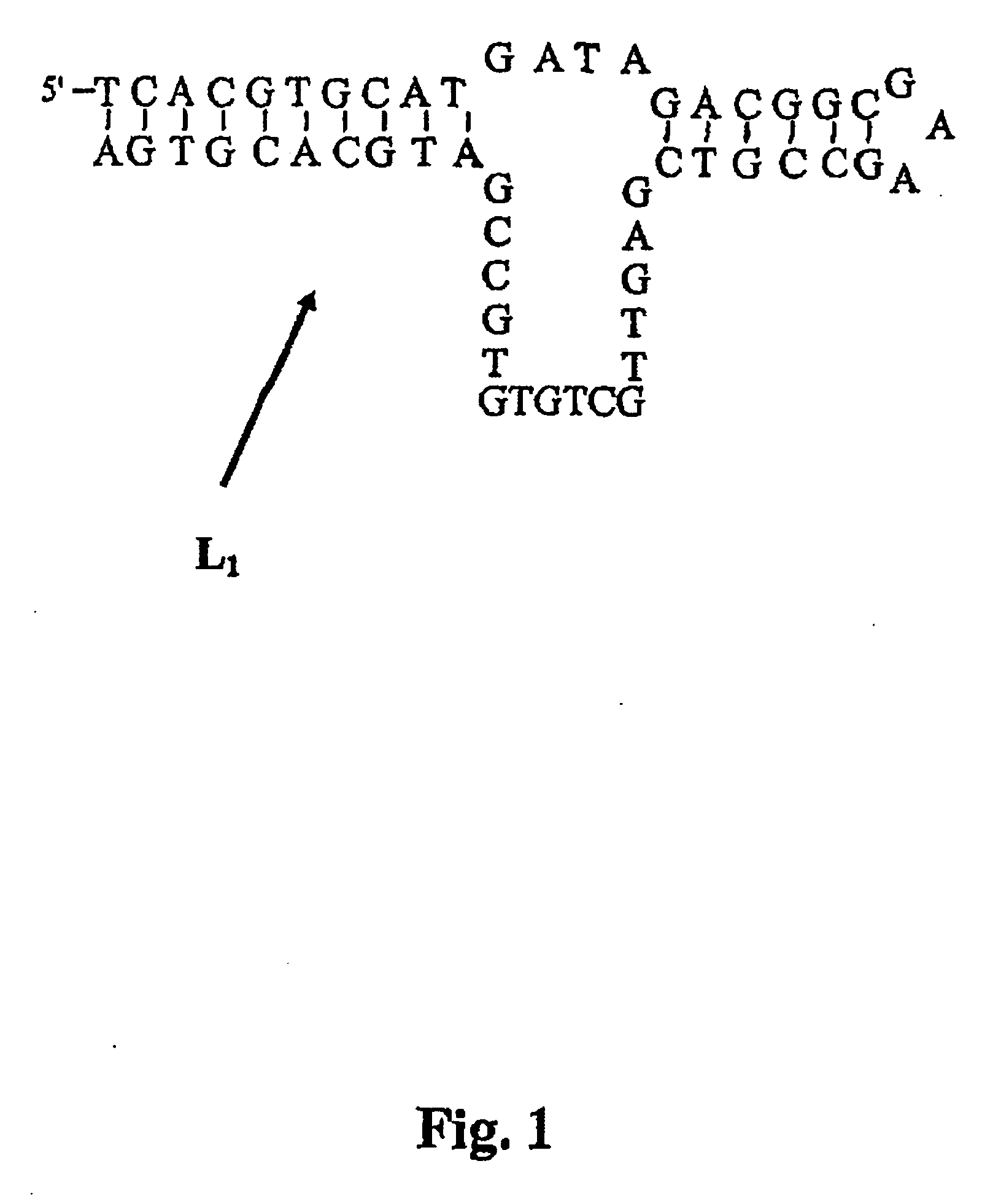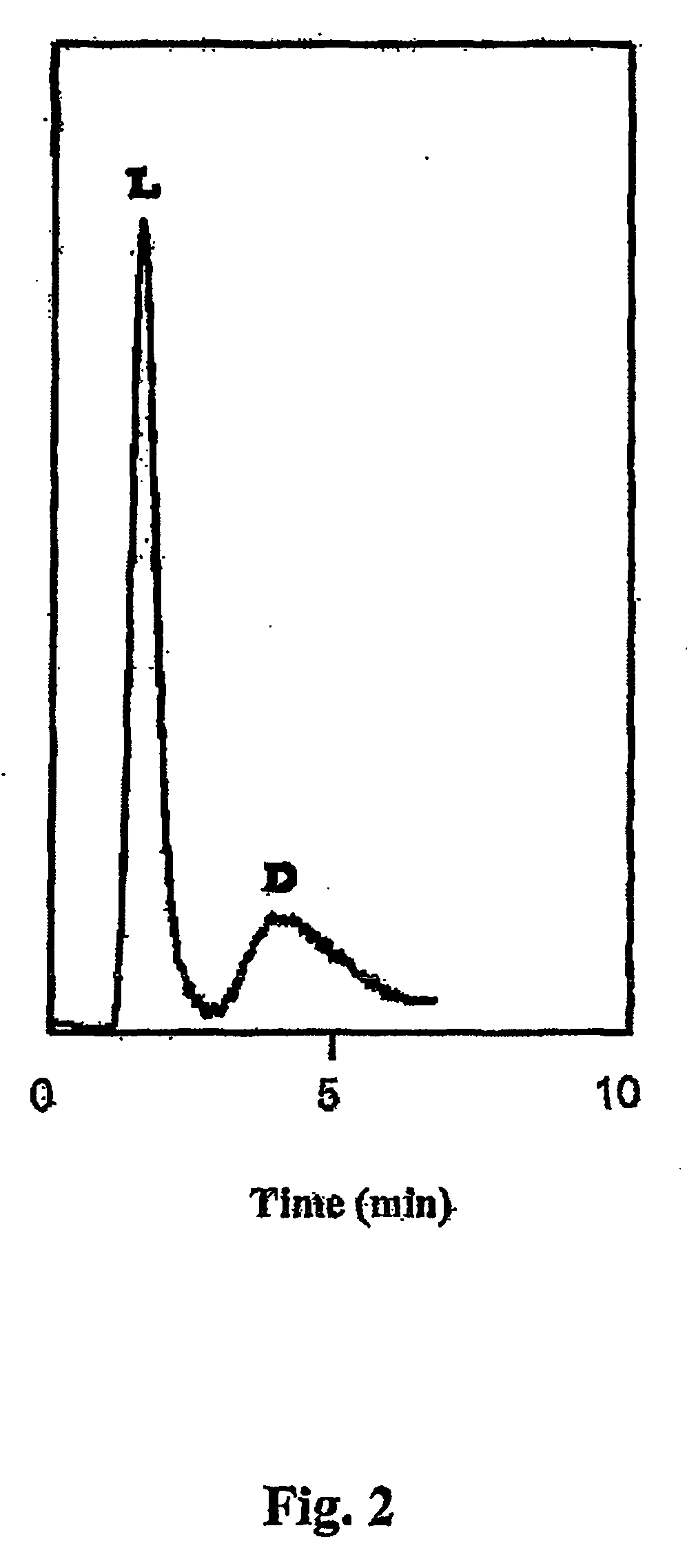Nucleic acids in the form of specific novel chiral selectors
a chiral selector and specific technology, applied in the field of chiral selectors of specific novel chiral selectors, can solve the problems of difficult analytical problems, no simple rule, and limit the possibility of grafting onto stationary phases, and achieve and high specificity and affinity
- Summary
- Abstract
- Description
- Claims
- Application Information
AI Technical Summary
Benefits of technology
Problems solved by technology
Method used
Image
Examples
example 1
Chromatographic Separation of Vasopressin Enantiomers
[0116] A DNA-series aptamer (biotinylated in the 5′ position) characterized by its enantioselectivity toward an oligopeptide, D-vasopressin, was immobilized on a chromatographic support containing streptavidin grafts. The stationary phase thus created was used for the purposes of chromatographic separation of vasopressin enantiomers.
1. Materials and Methods
[0117] 1.1. Reagents and Materials
[0118] The L series vasopressin (CYFQNCPRG-NH2) was provided by the company Sigma (Saint-Quentin, France). The D series vasopressin was synthesized by the company Millegen (Toulouse, France) from D series amino acids, and purified by reverse-phase polarity HPLC. The identity of the peptide was confirmed by mass spectrometry. Na2HPO4, NaH2PO4, KCl and MgCl2 were provided by Prolabo (Paris, France). The HPLC water was obtained by means of the Elgastate purification system (Odil, Talant, France). The 55-base DNA-series single-stranded oligonuc...
example 2
Use in Capillary Electrophoresis
[0145] The enantioselective properties of the aptamers can also be used in chiral capillary electrophoresis. Two possibilities are available to us:
[0146] Case 1: the aptamer is dissolved in the migration buffer at a concentration of the order of one millimolar,
[0147] Case 2: the aptamer is immobilized on a silica-type chromatographic support. In this case, the procedure will be carried out by electrochromatography.
1. Use of the Aptamer in the Liquid Phase
[0148] 1.1. Equipment
[0149] A capillary electrophoresis system comprising a capillary made of molten silica with an internal diameter of around 50 μm and a length of 40 cm, a power supply, an injection device and a fluorimetric detector (or a mass spectrometer) can be used.
[0150] 1.2. Operating Conditions
[0151] A migration buffer of the type 50 mM phosphate buffer, pH 7.0, containing 3 mM MgCl2 can be used. The aptamer of interest is dissolved in this buffer at a concentration of the order of...
example 3
Use of Nuclease-Resistant RNA as Aptamers
[0161] The RNA-series aptamers appear to have a more marked capacity for interacting with a predesignated target (in particular for small molecules) than the DNA-series aptamers. However, RNA is very sensitive to RNases in the environment and therefore degrades rapidly. However, at the current time, SELEX selection procedures established using modified bases, for example by substituting the —OH function in the 2′-position with an —F or an —NH2, exist (Jayasena, S. D. Clin. Chem. 1999, 45, 1628). This type of modified SELEX can be exploited for selecting a nuclease-insensitive RNA aptamer specific for a target enantiomer. The procedure used for the chiral separation is in all respects identical to that which has just been described in detail above.
[0162] Ultimately, based on effective in vitro selection studies directed toward optimal selection of enantioselective aptamers, a library of sequences specific for numerous enantiomer couples can ...
PUM
| Property | Measurement | Unit |
|---|---|---|
| Electrical resistance | aaaaa | aaaaa |
| Affinity | aaaaa | aaaaa |
Abstract
Description
Claims
Application Information
 Login to View More
Login to View More - R&D
- Intellectual Property
- Life Sciences
- Materials
- Tech Scout
- Unparalleled Data Quality
- Higher Quality Content
- 60% Fewer Hallucinations
Browse by: Latest US Patents, China's latest patents, Technical Efficacy Thesaurus, Application Domain, Technology Topic, Popular Technical Reports.
© 2025 PatSnap. All rights reserved.Legal|Privacy policy|Modern Slavery Act Transparency Statement|Sitemap|About US| Contact US: help@patsnap.com



